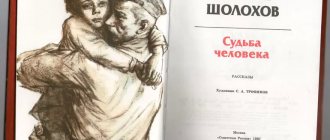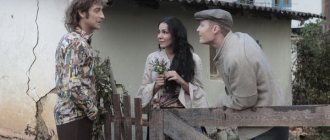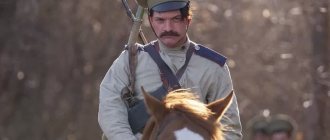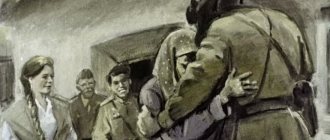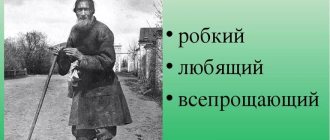The main characters of the story “The Fate of Man”:
When reading the short story “The Fate of Man”, it is important to get acquainted with its main characters. The characterization of the hero will help you understand the storyline of the work.
- Andrei Sokolov is the same soldier whose fate is discussed in the story. During the war, he worked as a driver and was one of those soldiers who did not fight for rank. Andrei Sokolov will be in captivity for two long years, will lose loved ones, but will not harden his heart.
- Anatoly is the son of Andrei Sokolov, who fought honestly and valiantly, like his father. Anatoly will fall from a sniper's bullet on Great Victory Day.
- Vanyushka is the adopted son of Andrei Sokolov.
The fate of soldiers captured by the Nazis
The fate of these people, as is now well known, was no less tragic than the fate of the soldiers who visited the front. It was not only the Nazis who brutally abused the prisoners. They were betrayed by their homeland itself - in the USSR they were treated as spies, enemies of the people. Upon returning home, prisoners of war were mostly exiled to various Gulag camps. Here they continued to endure the same torment as in captivity of the Germans.
But this is not what Sholokhov is talking about (“The Fate of Man”). The theme of war in his work is connected primarily with the image of the main character. The author focuses on the typical fate of a soldier who participated in the Great Patriotic War.
Minor characters in the story “The Fate of Man”:
The story contains a number of minor characters who remain, as it were, “behind the scenes” for the reader. They are episodic in the life of Andrei Sokolov.
- His wife Irina, daughters Nastenka and Olyushka are the deceased family of Andrei Sokolov, who live only in the memories of the protagonist.
- Kryzhnev is a traitor.
- Müller - Lagerfuhrer.
- The author is a minor but audible hero of the story, who met Sokolov and his Vanyusha at the crossing.
Narrator and main character
We begin our analysis of the work “The Fate of a Man” by Sholokhov with the images of the narrator and the main character, since the narrative is, as it were, divided between them, and in the center of it is the fate of Andrei Sokolov. In addition to Sholokhov, this narrative technique was used in his work, for example, by Lermontov in his work “A Hero of Our Time,” as well as by Gorky in romantic stories.
The narrator, as we learn from the exhibition, is a hero who is close to the writer. He is on his way to the Don village, but due to the flooding of the river he is forced to linger, waiting for a boat on the shore.
The awakening spring nature is rampant around, and this picture pleases the narrator, since it is a symbol of the revival of all life after a devastating war. The narrator enjoys the solitude and silence, but suddenly notices a man and a boy who are wearily wandering towards him. This is how we meet the main character - Andrei Sokolov.
War and captivity
Andrei was accompanied to the front by his children and wife. Irina had it the worst of all; she decided that she was seeing her husband for the last time. The hero waited for a long time for his wife to calm down, but she did not let up. Then he lightly pushed her away from him, offended that she was burying him ahead of time, which he regretted terribly afterwards. After all, a new meeting with his family never happened.
During the war, Sokolov served by profession as a driver. Was wounded twice. In May 1942 he was captured. One night, when a convoy with prisoners spent the night in the church, Sokolov killed the traitor Kryzhnev, who wanted to hand over to the Germans a platoon commander unfamiliar to the hero for his communist views. While he and other prisoners were being driven away, he tried to escape. The Nazis set dogs on the fugitive's trail and returned him to the camp.
Image of Andrey Sokolov
His portrait emphasizes the callous, rough, worn-out hands of the worker, as well as eyes filled with melancholy, as if sprinkled with ashes.
We understand, after analyzing the work “The Fate of Man” by Sholokhov, that the whole meaning of life for this war-torn character lies in his adopted son. It is no coincidence that Vanyusha’s clothes are much neater than his father’s. The hero cares first of all about the boy, not paying attention to himself.
Then we learn the fate of this character from his lips. Andrey is extremely frank with a random interlocutor - he does not hide personal details.
We can safely say that this hero had a happy life. After all, he had a loving wife, children, and he was doing what he loved. At the same time, Andrei’s life is typical for that time. Sokolov is a simple Russian man, of whom there were millions in our country at that time.
Release from captivity
After two years in captivity, Sokolov was assigned to drive a fascist major, who treated him tolerably and even threw him food. At the first opportunity, having stunned his boss, the hero fled to the front line and returned to his own.
While being treated in the hospital, Sokolov wrote a letter home. A neighbor sent him an answer, it said that Andrei no longer had a home, a wife, or daughters - only a shell crater where his family’s hearth had once been. Fortunately, Anatoly’s son was not there at the time of the bombing. He graduated from artillery school and went to the front.
Andrey's feat (“The Fate of a Man”, Sholokhov)
The essay “War in the life of the main character” can be built on the contrast of the attitude of Andrei and other people who meet on his life’s path towards it. In comparison with them, the feat that, in fact, is his whole life seems even more majestic and terrible to us.
The hero, unlike others, shows patriotism and courage. This is confirmed by the analysis of the work “The Fate of Man” by Sholokhov. So, during the battle, he plans to accomplish the almost impossible - to deliver shells to the Russian troops, breaking through the enemy’s barrier. At this moment he does not think about the impending danger, about his own life. But the plan could not be carried out - Andrei was captured by the Nazis. But even here he does not lose heart, maintains a sense of humor, self-esteem, and calmness. So, when a German soldier ordered him to take off the boots that he liked, Sokolov, as if mocking him, also takes off his foot wraps.
The work reveals various problems of Sholokhov. The fate of a person, anyone, not just Andrei, was tragic at that time. However, in front of her, different people behave differently. Sholokhov shows the horrors that occur in captivity of the Germans. Many people in inhuman conditions lost their face: in order to save life or a piece of bread, they were ready to commit any betrayal, humiliation, even murder. The stronger, purer, higher the personality of Sokolov, his actions and thoughts appear. Problems of character, courage, perseverance, honor - these are what interests the writer.
War is over
On the day of the Great Victory, a sniper killed Anatoly and Sokolov returned to his homeland alone. Saddened by the death of his son, the hero did not want to return to his hometown and went to his friend. There he got a job as a driver and met an orphan boy, Vanya. Taking pity on the homeless boy, Sokolov adopted him, and they lived together as one family. Taking care of little Vanyusha helped Sokolov survive the loss of his family.
Conversation with Mueller
And in the face of the mortal danger threatening Andrei (conversation with Muller), he behaves with great dignity, which even commands respect from his enemy. In the end, the Germans recognize the unbending character of this warrior.
It is interesting that the “confrontation” between Muller and Sokolov took place precisely at the moment when the fighting was taking place near Stalingrad. Andrei's moral victory in this context becomes, as it were, a symbol of the victory of the Russian troops.
Sholokhov also raises other problems (“The Fate of Man”). One of them is the problem of the meaning of life. The hero experienced the full echoes of the war: he learned that he had lost his entire family. Hopes for a happy life disappeared. He is left completely alone, having lost the meaning of existence, devastated. The meeting with Vanyusha did not allow the hero to die, to sink. In this boy, the hero found a son, a new incentive to live.
Mikhail Alexandrovich believes that perseverance, humanism, and self-esteem are traits typical of the Russian character. Therefore, our people managed to win this great and terrible war, as Sholokhov believes (“The Fate of Man”). The writer has explored the theme of man in some detail; it is even reflected in the title of the story. Let's turn to him.
“The Fate of Man”: summary. First day in captivity
The hero lay down on the ground and began to observe. First the German tanks drove by, and then the machine gunners came. It was sickening to look at them, but I didn’t want to die lying down. That’s why Sokolov stood up, and the Nazis headed towards him. One even took the machine gun off his shoulder. However, the corporal tested the soldier's muscles and ordered him to be sent west.
Soon Sokolov joined the column of prisoners from his own division. The horrors of captivity are the next part of the story “The Fate of Man.” Sholokhov notes that the seriously wounded were shot immediately. Two soldiers who decided to escape when it got dark also died. At night they entered the village, and the prisoners were driven into the old church. The floor is stone, there is no dome, and it also rained so much that everyone got wet. Soon, Sokolov, who was dozing, was woken up by a man: “Aren’t you wounded?” The hero complained of unbearable pain in his arm, and the military doctor, identifying the dislocation, set it in place.
Soon Sokolov heard a quiet conversation next to him. Let's give a brief summary of it. The fate of the person who spoke (it was a platoon commander) depended entirely on his interlocutor, Kryzhnev. The latter admitted that in the morning he would hand over the commander to the Nazis. The hero felt bad from such a betrayal, and he immediately made a decision. When it was just dawn, Sokolov signaled to the platoon commander, a thin and pale boy, to hold the traitor by the legs. And he leaned on the strong Kryzhnev and squeezed his hands on his throat. This is how the hero killed a person for the first time.
In the morning they began to ask communists and commanders, but there were no more traitors. Having shot four at random, the Nazis drove the column further.
Start of the war
Formed in Ukraine. Sokolov received a truck and drove it to the front. They wrote from home often, but he himself rarely answered: everyone retreated, but I didn’t want to complain. The car came under fire more than once and received two minor wounds. And in May '42 he was captured. Sokolov described to the author the circumstances of this absurd, as he put it, incident. This was his story.
A person's fate in war often depends on circumstances. When the Nazis advanced, one of the Russian batteries found itself without shells. They should have been delivered to Sokolov in his truck. It was going to be a difficult task - to break through to our own people through the shelling. And when there was about a kilometer left to reach the battery, the hero felt as if something had burst in his head. When he woke up, he experienced severe pain throughout his body, stood up with difficulty and looked around. A car lies overturned nearby, and shells intended for the battery are scattered around. And the sounds of battle are heard somewhere behind. So Sokolov ended up behind the German lines. Sholokhov described all these events very vividly.
The meaning of the story's title
The story “The Fate of a Man” is named so not by chance. This name, on the one hand, convinces us that the character of Andrei Sokolov is typical, and on the other, it also emphasizes his greatness, since Sokolov has every right to be called a Man. This work gave impetus to the revival of the classical tradition in Soviet literature. It is characterized by attention to the fate of a simple, “little man” worthy of full respect.
Using various techniques - confessional story, portrait, speech characterization - the author reveals the character of the hero as fully as possible. This is a simple man, majestic and beautiful, self-respecting, strong. His fate can be called tragic, since Andrei Sokolov suffered serious trials, but we still involuntarily admire him. Neither the death of loved ones nor the war could break him. “The Fate of Man” (Sholokhov M. A.) is a very humanistic work. The main character finds the meaning of life in helping others. This is what, above all, the harsh post-war times required.
